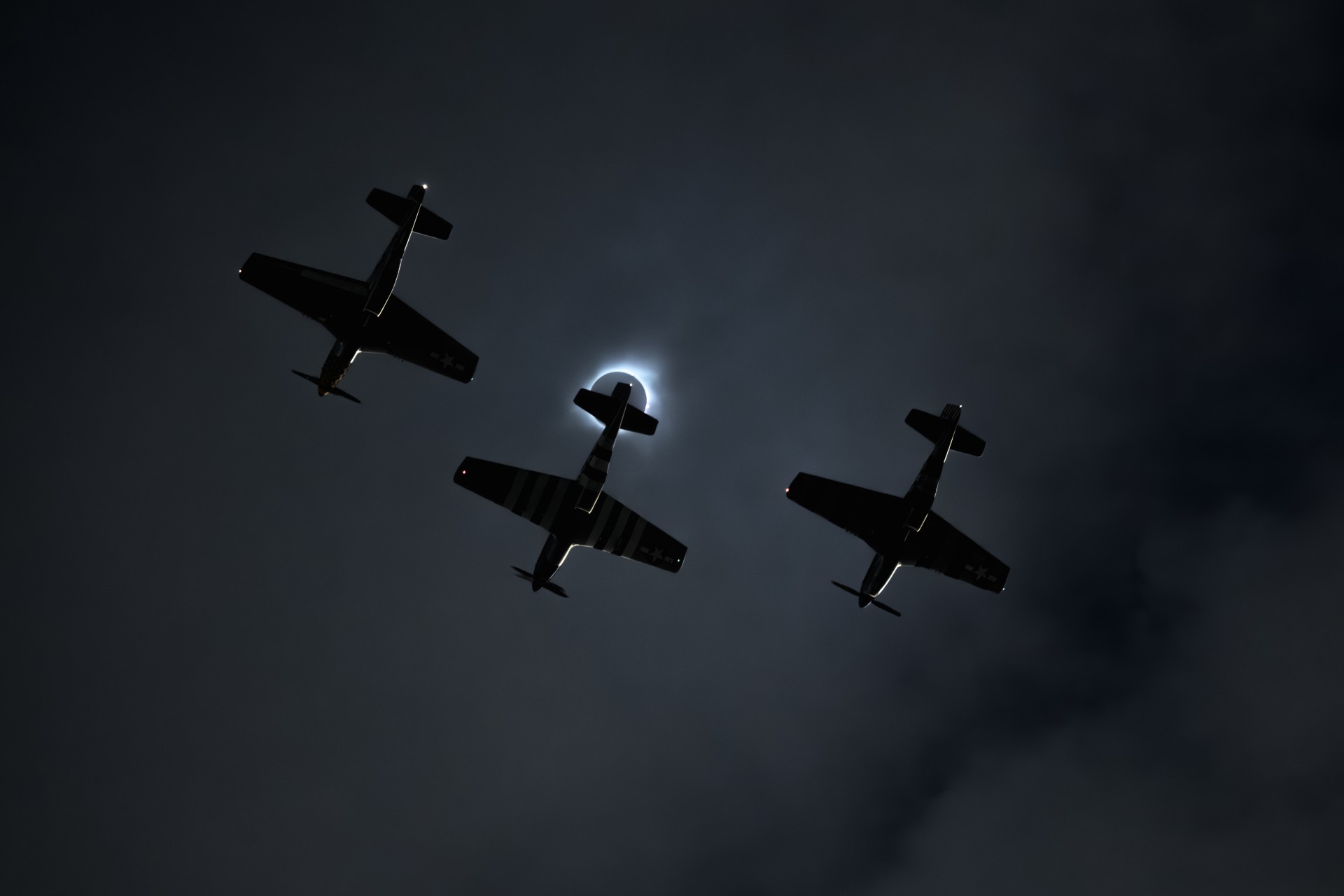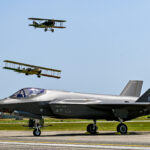By Stepehn Chapis
The first time an aircraft “chased” the totality of a total solar eclipse was in 1973 when the Concorde prototype, loaded with scientists, remained in totality for over an hour as it streaked across northern Africa at more than 1,500mph. In the past seven years, one area or another of the Continental United States has experienced three eclipses — two total and one annular — and thanks to social media and the continuing development of advanced digital cameras of all shapes and sizes, these celestial events have been documented from aircraft ranging from private paragliders and RV-4s to NASA WB-57s and Gulfstreams.

On Monday April 8th 2024, as a total solar eclipse made its way across the United States, photographs of totality taken from the ground and the air began to appear on Facebook and Instagram. Early that evening, as posts began to wane a little, Jim Beasley, Jr. blew up Facebook when he posted four incredible photos of The Horsemen Flight Team’s three North American P-51 Mustangs in totality. The photos came with a simple statement, “Horsemen demo team during totality in southwest Texas, 8 April 2024.” Among the hundreds of comments on the post, Brad Haskin said, “…the day Jim won the internet.” In an interview with Vintage Aviation News the following day Jim modestly said, “I don’t know about that. It seems like some people liked it.”
Whereas NASA, the military, and thousands of photographers across the continent planned for the moment, weeks, months, even years ahead of time, The Horsemen’s plans were initiated on Saturday April 6th — two days prior to the eclipse! Jim laughingly related, “It was Dan Friedkin’s idea. He texted [Ed] Shipley and I on Saturday, and he’s like, ‘Hey man, why don’t we try this?’ We’re like, ‘Okay.’ So, it was all Dan. His ranch in Texas was right in the path of totality, and he has some of his planes down there. So, Ed and I caught a flight out of Philly and got down there around two o’clock on Sunday, so it wasn’t like we’d been thinking about this since 2017.”
The formation of Mustangs consisted of Jim leading in P-51C Princess Elizabeth, Ed on the left wing in P-51D Double Trouble two, and Dan on the right wing in P-51D Fragile But Agile. They flew three “gos” on Sunday afternoon with Major General Tommy Williams USAF (Ret) at the controls of Dan’s Pilatus PC-7. Jim elaborated, “I went up in Fragile but Agile, so we could figure out positioning for the PC-7 using just a single Mustang as the photo platform and assuming that the sun was going to be 12 o’clock high. We flew around and figured out what seemed to make sense. Then we did another go with the photographer/videographer in the back at sunset and as close to dark as possible. Then we did a third flight because the PC-7 has all the Garmin TV screens and stuff, and we weren’t sure exactly how dark it was going to get or if we would have to put covers on the screens. We also had Ed in the backseat because he has a pretty good eye for that stuff.” Since the team was unsure of how dark it would get in totality, they also tested the nav and landing lights on the Mustangs.

Weather forecasts for many of the areas in the path of totality, including Texas, were bleak in the days leading up to the event and in some cases, those forecasts turned out to be correct. For The Horsemen, the weather on Monday morning did not look good as Jim explained, “The clouds were iffy, and it was looking funny so, we went up and did a scouting flight about an hour before it started. The cloud tops were around 6-8,000 feet, then it was clear.
“We took off at 12:55 local, and the totality was going to start, I guess, at 1:29 or something, so we gave ourselves plenty of time. We joined up and climbed through the broken layer and when we got on top there was a higher cirrus layer, but it was beautiful. Then we just waited for the eclipse to start.” The cirrus layer Jim mentioned was eight to twelve thousand feet above their formation and while they waited for the approach of totality Jim could see areas where the sun was shining through the cirrus layer better than others and would head for those areas to check the lighting. In the PC-7, Tommy Williams was also looking for the best areas of light. “He was helpful in positioning us,” Jim related. “He would just say, ‘Hey, go 20 degrees to the right for five miles’, or this and that and I would just go to those spots.”
When totality washed over The Horsemen the trio of Mustangs were bathed in a light unlike anyone has ever seen or will ever see again. The darkness of the ground below and the clouds above placed the wings of the Mustangs in darkness while the polished flanks of their fuselages were illuminated in the golden light at the edges of totality.

We’ve seen the photos of the team in totality, but VAN wanted to get Jim’s impression of what those minutes were like in the cockpit of Princess Elizabeth, especially since they were among the first in the United States to witness the event due to the Comanche Ranch’s close proximity to the U.S.-Mexico border. “We were down in that Laughlin, Del Rio area. They have an MOA [military operations area] down there. We were no closer than 10 or 15 miles to Mexico, so the airspace itself was not an issue. The thing is we just had to climb through some holes to get on top. The pictures don’t really do it justice, but during totality, there was this weird ring of fire on the horizon where sunlight was partly visible. So, it wasn’t night. It was more like dusk, but dark enough that I needed to turn on the cockpit lights. It was pretty cool,” Jim related.
There will not be another total solar eclipse in the United States until August 23rd, 2044, and August 12th, 2045. No one knows where they will be in two decades or if these Mustangs will still be flying at 100 years old. That being said, warbird enthusiasts around the world owe a debt of gratitude to Dan Friedkin and The Horsemen Flight Team for capturing these brief moments when the three horsemen rode through the darkness of totality of what, for many, will be a last-in-a-lifetime cosmic event. Unlike us, these images will live forever as will the legacy of the P-51 Mustang and The Horsemen Flight Team.





























